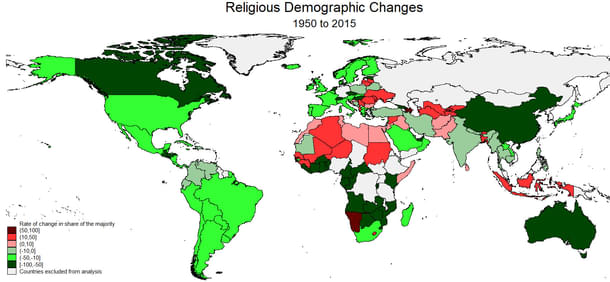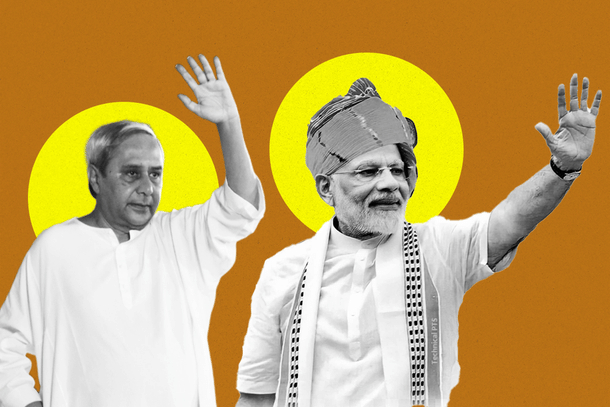Newsletters
Is The World Changing?
Amar Govindarajan
May 07, 2024, 07:10 PM | Updated 07:10 PM IST
Save & read from anywhere!
Bookmark stories for easy access on any device or the Swarajya app.
We are all ears!

Dear Reader
We're very curious to know what you think about our new newsletter format and content style. Do you like this? Would you like more opinion or data? What makes it work for you?
We'd really love to hear from you. Please hit reply to this email and let us know what you think.
- Amar Govindarajan
PS: Some of the best feedback - positive or negative - will receive Swarajya merch goodies!
New paper on Demography! (..tells a story!)

The Prime Minister's Economic Advisory Council (PM-EAC) has published a new paper on demography.
Authored by PM-EAC member Shamika Ravi, Abraham Jose and Apurv Mishra
The paper does a detailed cross-country analysis of the share of religious minorities in 167 countries from 1950 to 2015.
Why study demographic share of religious minorities? The world is seeing major demographic transitions across nations - these transitions have the power to reshape societies and states.
Shifting demographic trends are aggravating economic disparity within and between countries
They are also straining governance and fuelling friction between states and people.
...but demographic changes are going unnoticed by analysts ranging from economy-watchers to democracy-watchers
But why study 'minority demographics'? The change in the proportion of minorities as a share of the total population serves as a reliable proxy for the status of minorities in a country.
The share of the majority religious denomination for 167 countries have, on average, reduced by 22% from 1950-2015.
Findings reveal a story about declining majorities. 123 countries experienced a decrease in the share of the majority denomination between 1950 - 2015.
India has seen the second most significant decline in the majority population (7.82%)
..but minority populations have shrunk substantially in Bangladesh, Pakistan, Sri Lanka, Bhutan and Afghanistan.
Question: How will these demographic shifts reflect in the polity of the respective countries?
(All data and insights above are from the paper)
Odisha BJP's Two Pronged Attack Against Patnaik

The state of Odisha is also going to polls for electing a new legislative assembly. After some to and fro, the ruling BJD and the BJP have chosen to not have an alliance between themselves.
PM Modi's recent rallies and a slew of 'benefits' announced in the party's manifesto may give it a lot of electoral momentum.
Odisha BJP prefers to go it alone. Because it's the only way for the party to grow.
State leaders of the BJP had also strongly opposed the proposal to form an alliance with the BJD
With Odisha CM and BJD Chief Naveen Patnaik beginning to slowly plan his political succession, the state unit believes now is the time!
Modi goes on anti-Patnaik offensive. The PM and Naveen Patnaik have always had cordial relations but new political fronts have opened, changing equations considerably.
Modi even launched a direct attack on Naveen Patnaik.
“Why is it that the home turf of Naveen Patnaik (he represents the Hinjili seat in Ganjam district) witnesses the maximum migration of people to other parts of the country in search of jobs?"
"We send money for free rations to the poor, but the BJD government pastes its own stickers on the bags of free rice. Why does it have to do this?"
Modi’s severe criticism of the BJD government came on the heels of the release of the party manifesto for the state
The BJP puts out a generous manifesto. The party has learnt its lessons in Karnataka where its promises paled in comparison to reckless freebie regime announced by the Congress.
Targeting women voters: Every woman will receive a cash voucher of ₹50,000 which can be encashed over two years.
Infra: 75,000 km of rural and State highway roads connecting all gram panchayats, district headquarters, and the State capital.
For farmers: Payment of ₹3,100 per quintal during paddy procurement and direct benefits transfer (DBT)
(It's heartening to see free bus tickets, free electricity and other such financially ruinous programs NOT find a place in the manifesto!)
This note was informed largely by ground reports sent by my colleague Jaideep Mazumdar, who is now traveling across the state.





